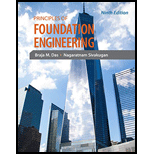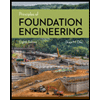
Concept explainers
Find the percentage of load carried by the shaft.
Answer to Problem 13.1P
The percentage of load carried by the shaft is
Explanation of Solution
Given information:
The diameter of the base
The total length (L) is 27.0 ft.
Unit weight of loose sand
Unit weight of dense sand
The diameter of the shaft
The length of the shaft
The value of factor of safety (FOS) is 4.
Consider
Calculation:
Find the area of the base
Substitute
From given Figure, find the effective stress of soil.
Find the ratio
Substitute 27 ft for
Refer Table 13.3. “Berezantzev et al.’s value of
The value of
Find the bearing capacity factor
Substitute
Find the net ultimate load carrying capacity at the base
Substitute
Find the shaft load
Find the perimeter of the shaft
Substitute 2.5 ft for
Find the value of
Substitute
Find the value of
Substitute
Find the critical depth
Substitute 2.5 ft for
The value of critical depth 37.5 ft is more than the length
Find the frictional resistance
At depth
At depth
Substitute 0.485 for K,
Find the load carrying capacity of the shaft
Find the ultimate load
Substitute
Find the allowable load
Substitute
Find the percentage of load carried by the shaft:
Substitute
Therefore, the percentage of load carried by the shaft is
Want to see more full solutions like this?
Chapter 13 Solutions
Principles of Foundation Engineering (MindTap Course List)
- A free-headed drilled shaft is shown in Figure P13.10. Let Qg = 260 kN, Mg = 0, = 17.5 kN/m3, = 35, c' = 0, and Ep = 22 106 kN/m2. Determine a. The ground line deflection, xo b. The maximum bending moment in the drilled shaft c. The maximum tensile stress in the shaft d. The minimum penetration of the shaft needed for this analysisarrow_forwardFor the drilled shaft described in Problem 19.7, estimate the total elastic settlement at working load. Use Eqs. (18.45), (18.47), and (18.48). Assume that Ep = 20 106 kN/m2, s = 0.3, Es = 12 103 kN/m2, = 0.65 and Cp = 0.03. Assume 80% mobilization of skin resistance at working load. (See Part c of Problem 19.7) 19.7 Figure 19.16 shows a drilled shaft without a bell. Here, L1 = 6 m, L2 = 7 m, Ds = 1.5 m, cu(1) = 50 kN/m2, and cu(2) = 75 kN/m2. Find these values: a. The net ultimate point bearing capacity. Use Eqs. (19.23) and (19.24) b. The ultimate skin resistance. Use Eqs. (19.26) and (19.28) c. The working load, Qw (FS = 3) FIG. 19.16arrow_forwardA 3 ft diameter straight drilled shaft is shown in Figure P13.7. Determine the load-carrying capacity of the drilled shaft with FS = 3. Take / as 0.8 for the sand.arrow_forward
- Refer to Figure 11.26b. For the drilled shaft with bell, given:Thickness of active zone, Z = 9 mDead load = 1500 kN Live load = 300 kNDiameter of the shaft, Ds = 1 mZero swell pressure for the clay in the active zone = 600 kN/m2Average angle of plinth-soil friction, Φ'ps = 20°Average undrained cohesion of the clay around the bell = 150 kN/m2. Determine the diameter of the bell, Db. A factor of safety of 3 against uplift is required with the assumption that dead load plus live load is equal to zero.arrow_forwardA square hollow bar having an outside dimension of 250 mm by 250 mm with 6 mm thick is to be replaced by a soild circular bar. a. Determine the required diameter of bar so that the maximum shear stress in the bar will not exceed the maximum shear stress in the tube. b. If the computed value of diameter in the previous question increase by 15%, what is the new shear stress of the circular bar? Determine the angle of twist in degrees of the tube if the length of the tube is 1m and the shear modulus is 80 GPa. Use T=14 kN-m.arrow_forward1. Triaxial compression tests are done on quartzite rocks, the results are shown below. (0₁+03)/2 -964.25 14500 19575 23200 29000 43210 63075 psi (01-03)/2 964.25 14500 18850 21750 26100 35960 48575 psi Comment on the applicability of each of the Mohr-Coulomb, Griffith, and Hoek-Brown criteria for the testing results.arrow_forward
- A 20 mm diameter hole is drilled on the centerline of a steel strap 50 mm wide by 5 mm thick, subjected to an axial pull P = 10 kN. Determine the approximate maximum unit stress adjacent to the hole. Hint: This is a stress concentration question. The first step is to calculate the K value. Select one: O a. 0.1 kN/mm? b. 0.0733 kN/mm? c. 0.146 kN/mm2arrow_forwardHint: The problem is 10.10 taken from the book " introductory to mining engineering " written by "Howard L.Hartman" A single rectangular opening 10 ft in height is driven in rock having strengths of fc=18000 lb/in2 and ft= 1500 lb/in2. Rock specific gravity is 2.3. The opening is located at a depth of 2000 ft in a stress field of no lateral pressure and has a fillet ratio of 1/6. (a). Determine if the opening will fail when its width is 20 ft ? (b). What is the maximum safe width of the opening?.A single rectangular opening 10 ft (3.0 m) in height is driven in rock having strengths of fc = 18,000 lb/in2 (124 MPa) and ft=1500 lb/in2. (10.3 MPa).Rock specific gravity is 2.3.The opening is located at depth of 2000 ft (610 m) in a stress field of no lateral pressure and has a fillet ratio of 1/6 .a. Determine if the opening will fail when its width is 20 ft (6.1 m).b. Is there any benefit to reducing the width to 10 ft (3.0 m)? To 5 ft (1.5 m)?c. What is the maximum safe width of opening?arrow_forwardTake o, = 580 kPa (Figure 1) Express your answer to three significant figures and include the appropriate units. HÀ ? o, = Value Units Submit Request Answer Figure Part B Determine the shear stress acting on the inclined plane AB. Express your answer to three significant figures and include the appropriate units. В HA ? 30° Value Units Aarrow_forward
- For a given circular shaft of diameter 'D' having length Tsubjected to a torque T. If a concentric hole of diameter drilled throughout the length of the shaft to develop same maximum shear stress, then the value of torque T must be reduced by T.arrow_forwardA hollow circular tube is subjected to a tension force of 30 KN, a tensile stress of 20 MPa was recorded.lf the outer diameter of the tube is 100 mm, the inner diameter will be eqaual to. a. 93.95 mm O b. 89.95 mm C. 85.95 mm o d. 91.95 mmarrow_forwardNumerical Analysis (HW. #1) The vertical stress increment (Ao) due to a point load acting on the surface of linearly elastic medium is given as: 3P23 Ao 27Vr? + z? where P is the magnitude of the load, r is the lateral distance, and z is the depth of the point where the stress is to be calculated. If P = 10g kN and r = using two methods: fixed-point and Newton-Raphson method) the depth z at which the stress increment Ao = 10n kN/m?. (Take g=student group number A=1, B=2, 1.5 m, determine (by C=3, D=4, and E=5, n=student number in his/her group, and & =1x10-6)arrow_forward
 Principles of Foundation Engineering (MindTap Cou...Civil EngineeringISBN:9781337705028Author:Braja M. Das, Nagaratnam SivakuganPublisher:Cengage Learning
Principles of Foundation Engineering (MindTap Cou...Civil EngineeringISBN:9781337705028Author:Braja M. Das, Nagaratnam SivakuganPublisher:Cengage Learning Fundamentals of Geotechnical Engineering (MindTap...Civil EngineeringISBN:9781305635180Author:Braja M. Das, Nagaratnam SivakuganPublisher:Cengage Learning
Fundamentals of Geotechnical Engineering (MindTap...Civil EngineeringISBN:9781305635180Author:Braja M. Das, Nagaratnam SivakuganPublisher:Cengage Learning Principles of Foundation Engineering (MindTap Cou...Civil EngineeringISBN:9781305081550Author:Braja M. DasPublisher:Cengage Learning
Principles of Foundation Engineering (MindTap Cou...Civil EngineeringISBN:9781305081550Author:Braja M. DasPublisher:Cengage Learning


